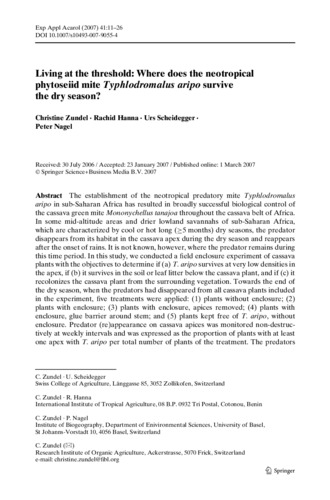Living at the threshold: where does the neotropical phytoseiid mite Typhlodromalus aripo survive the dry season?
Abstract
The establishment of the neotropical predatory mite Typhlodromalus aripo in sub-Saharan Africa has resulted in broadly successful biological control of the cassava green mite Mononychellus tanajoa throughout the cassava belt of Africa. In some mid-altitude areas and drier lowland savannahs of sub-Saharan Africa, which are characterized by cool or hot long (≥5 months) dry seasons, the predator disappears from its habitat in the cassava apex during the dry season and reappears after the onset of rains. It is not known, however, where the predator remains during this time period. In this study, we conducted a field enclosure experiment of cassava plants with the objectives to determine if (a) T. aripo survives at very low densities in the apex, if (b) it survives in the soil or leaf litter below the cassava plant, and if (c) it recolonizes the cassava plant from the surrounding vegetation. Towards the end of the dry season, when the predators had disappeared from all cassava plants included in the experiment, five treatments were applied: (1) plants without enclosure; (2) plants with enclosure; (3) plants with enclosure, apices removed; (4) plants with enclosure, glue barrier around stem; and (5) plants kept free of T. aripo, without enclosure. Predator (re)appearance on cassava apices was monitored non-destructively at weekly intervals and was expressed as the proportion of plants with at least one apex with T. aripo per total number of plants of the treatment. The predators reappeared first on the plants of the treatments (1), (2), and (4). With a time lag of 7–8 weeks, the predators appeared also on the plants of the treatments (3) and (5). The time pattern of the predator’s (re)appearance in the cassava apex of the different treatments suggests that (a) T. aripo survives the dry season in very low densities in the cassava apex; this result is supported by an assessment of the efficiency of non-destructive visual in-field apex inspections which proved that about 10% of the cassava apices that had T. aripo were not recognized as such; (b) T. aripo does not survive in the soil or leaf litter, but we did document cases in a screenhouse experiment, where few individuals migrated down to the ground and walked over exposed soil until they reached the apex bouquet traps; additionally, microclimate measurements in various cassava plant strata proved that the cassava apex and the cassava stem base are the locations with the highest relative humidity during the dry season—which makes the stem base a potentially interesting refuge; (c) T. aripo does not survive in the surrounding vegetation, which is supported by a vegetation survey, where T. aripo was not found on any other plant species than cassava.

